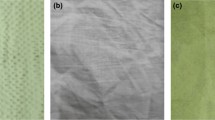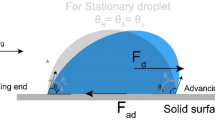Abstract
The average evaporation in Iran is 3 times higher than the world average. Applying chemical monolayers on water surfaces is one of the promising methods for suppressing the evaporation. Literature studies have shown that the mixture of cetyl and stearyl (ratio of 1 to 9) is the state-of-the-art monolayer to minimize the evaporation. Adding calcium hydroxide increases the spreading rate and self-healing of the monolayer. Despite long study and investigation on monolayers, there are inconsistencies in explaining the mechanism by which monolayers decrease the evaporation. The mechanisms used to explain the evaporation reduction are: (i) increasing the reflected solar radiation, (ii) dampening the waves formed by winds and decreasing the water surface area, consequently, and (iii) limiting the escape of water molecules. In this paper, by design of experiments (DOE), we try to answer the above question. Evaporation rate from a container in absence of wind or low wind (~0.2 m/s) and at moderate temperature and relative humidity (~20 °C and 45%) is ~ 10 mm/day. Utilization of the monolayer can save 41% of the evaporated water. Also, in absence of radiation, a 9 m/s wind caused ~ 15 mm/day evaporation. By increasing the wind speed from 0 to 9 m/s, effectiveness of the monolayer deteriorated from 60 to 13%. Therefore, the main mechanism is neither reflecting the radiation (as in absence of radiation, monolayer was still effective) nor dampening the waves and decreasing the surface area (as in absence of wind, monolayer was effective; also, at higher wind speeds where the surface area increases, monolayer efficiency decreases). Therefore, the main mechanism by which monolayers decrease the evaporation rate is limiting the escape of water molecules. So, monolayers may be effective even during the nights even though radiation is at its lowest.





Similar content being viewed by others
Notes
0.01 mg per meter squared.
References
Abbaspour KC, Faramarzi M, Ghasemi SS, Yang H (2009) Assessing the impact of climate change on water resources in Iran. Water Resour Res 45(10):W10434
Babu P, Eikaas HS, Price A, Verlee D (2010) Reduction of evaporative losses from tropical reservoirs using an environmentally safe organic monolayer. Accessed July 2019. Available at http://www.flexiblesolutions.com/products/watersavr/documents/ReductionofEvaporativeLossesfromTropical.pdf
Behrouzi K, Chini SF (2017) Evaluation of evaporation estimation methods: a case study of Karaj dam Lake. J Comput Appl Mech 48(1):137–150
Binks BP (1991) Insoluble monolayers of weakly ionising low molar mass materials and their deposition to form Langmuir-Blodgett multilayers. Adv Colloid Interf Sci 34:343–432
Chini SF, Amirfazli A (2013) Understanding the evaporation of spherical drops in quiescent environment. Colloids Surf A Physicochem Eng Asp 432:82–88
Cleugh HA (1998) Effects of windbreaks on airflow, microclimates and crop yields. Agrofor Syst 41(1):55–84
Cooley KR (1970) Energy relationships in the design of floating covers for evaporation reduction. Water Resour Res 6(3):717–727
Craig I (2008) Loss of storage water through evaporation with particular reference to arid and semi-arid zone pastoralism in Australia. Working paper no. 19, the WaterSmart™ literature reviews
Deo AV, Sanjana NR, Kulkarni SB, Gharpurey MK, Biswas AB (1960) New compounds for the control of water evaporation. Nature 187(4740):870
Devaux HE (1913) Oil films on water and on mercury, Annu rep Board Regents Smithson Inst, (Washington, D.C., 1913), pp. 261–273. Available at: https://library.si.edu/digital-library/book/annualreportofbo1913smit
Falkenmark M (1979) Main problems of water use and transfer of technology. GeoJournal 3(5):435–443
Forer LG (1961) Water supply: suggested federal regulation. Harvard Law Review 196:332–349
Frenken K (2009) Irrigation in the Middle East region in figures AQUASTAT Survey-2008. Water Reports, 34
Gaines GL Jr (1966) Insoluble monolayers at liquid-gas interfaces. Interscience Publishers, New York
Gladyshev M (2002) Biophysics of the surface microlayer of aquatic ecosystems. IWA Publishing, London
Grundy F (1962) Some problems of maintaining a monomolecular film on reservoirs affected by winds. In: Retardation of evaporation by monolayers. Academic, New York, pp 213–218
Gugliotti M, Baptista MS, Politi MJ (2005) Reduction of evaporation of natural water samples by monomolecular films. J Braz Chem Soc 16(6A):1186–1190
Hedestrand G (1924) On the influence of thin surface films on the evaporation of water. J Phys Chem 28(12):1245–1252
Helfer F, Zhang H, Lemckert C (2010) Evaporation reduction by windbreaks: overview, modelling and efficiency. Urban Water Security Research Alliance
Kubo M, Hanada T, Yoshimura A (2003) Suppressors of cytokine signaling and immunity. Nat Immunol 4(12):1169
La Mer VK (ed) (2014) Retardation of evaporation by monolayers: transport processes. Academic, New York
Langmuir I (1933) Oil lenses on water and the nature of monomolecular expanded films. J Chem Phys 1(11):756–776
Magin GB, Randall LE (1960) Review of literature on evaporation suppression. US Government Printing Office, Washington, D.C.
McArthur IKH, Durham K (1957) Fatty alcohols for water conservation. In: Proc. 2nd Int. congress of surface activity, vol 6, pp 262–269
McGuire Environmental Consultant Inc. (2004) Production Evaluation-WaterSavr™. https://www.flexiblesolutions.com/products/watersavr/documents/McGuire_Report_WaterSavr.pdf
McJannet D, Cook F, Knight J, Burn S (2008) Evaporation reduction by monolayers: overview, modelling and effectiveness. Urban Water Security Research Alliance Technical Report, 6, 1–32
McNamee CE, Barnes GT, Gentle IR, Peng JB, Steitz R, Probert R (1998) The evaporation resistance of mixed monolayers of octadecanol and cholesterol. J Colloid Interface Sci 207(2):258–263
Miller IR, Bavly-Luz A (1962) Some physical properties of monolayers and their relation to evaporation retardation. In: Retardation of evaporation by monolayers. Academic, New York, pp 161–175
Norkrans B (1980) Surface microlayers in aquatic environments. In: Advances in microbial ecology. Springer, Boston, pp 51–85
O’brien RN (2001) U.S. patent no. 6,303,133. U.S. Patent and Trademark Office, Washington, DC
O’brien R (2006) U.S. patent application no. 10/910,950
Otieno FAO, Ochieng GMM (2004) Water management tools as a means of averting a possible water scarcity in South Africa by the year 2025. Water SA 30(5):120–124
Panjabi K, Rudra R, Goel P (2016) Evaporation retardation by monomolecular layers: an experimental study at the Aji reservoir (India). Open Journal of Civil Engineering 6(03):346
Pittaway P, Van den Ancker T (2010) Microbial and environmental implications for use of monolayers to reduce evaporative losses from water storages (no. 07/10). CRC for Irrigation Futures
Quinn F (2007) Water diversion, export, and Canada-US relations: a brief history. Munk Centre for International Studies
Roberts WJ (1957) Evaporation suppression from water surfaces. EOS Trans Am Geophys Union 38(5):740–744
Saylor JE, Barnes GT (1971) Spreading rates of long-chain alcohol-decane mixtures. J Colloid Interface Sci 35(1):143–148
Schouten P, Lemckert C, Turnbull D, Parisi A, Downs N, Underhill I, Turner G (2011) Chemical films and monolayers on the water surface and their interactions with ultraviolet radiation: a pilot investigation. Meas Sci Technol 22(6):065703
Schultz TW, Kissel TS, Tichy M (1994) Structure-toxicity relationships for unsaturated alcohols to Tetrahymena pyriformis: 3-alkyn-1-ols and 2-alken-1-ols. Bull Environ Contam Toxicol 53(2):179–185
Smith RL (1984) Review of glycol ether and glycol ether ester solvents used in the coating industry. Environ Health Perspect 57:1–4
Sophiane J, Djamel B (2012) Evaporation Reduction of Water Plans in Arid zones by Monomolecular Films (Case of Ouargla) http://citeseerx.ist.psu.edu/viewdoc/download?doi=10.1.1.302.4188&rep=rep1&type=pdf
The Islamic Republic News Agency (IRNA) (2014) Water Evaporation in Iran is 3 Times the Global Rate. www.irna.ir/news/81077378/
U.S. Environmental Protection Agency (2009) Short-Chain Chlorinated Paraffins (SCCPs) and Other Chlorinated Paraffins Action Plan. https://www.epa.gov/sites/production/files/201509/documents/sccps_ap_2009_1230_final.pdf
Wixson BG (1967) Studies on the ecological impact of evaporation retardation monolayers. Doctoral dissertation, Texas A & M University
Acknowledgements
This work has been supported by the Center for International Scientific Studies & Collaboration (CISSC) under the contract No. 1715. Authors would like to thank CISSC for their financial support.
Author information
Authors and Affiliations
Corresponding author
Ethics declarations
Conflict of Interest
No potential conflict of interest was reported by the authors.
Additional information
Publisher’s Note
Springer Nature remains neutral with regard to jurisdictional claims in published maps and institutional affiliations.
Appendix
Appendix
To make sure that the shrink wrap does not affect the solar radiation, two identical containers with pure water are tested. One of the containers was covered by shrink wrap. The level of water in both containers was measured every 4 h and for 24 h. This experiment was repeated 3 times and average results are presented in Fig. 6. It is shown that the solar radiation absorbed or reflected by the shrink wrap is negligible. As it is clear from Fig. 6, by comparing these two containers, the difference between height of water in both containers is 1 mm. This shows us that the shrink-wrap only slightly absorbs the radiation and it can be assumed that the amount of radiation that enters the body of water is the same for both containers.
Rights and permissions
About this article
Cite this article
Mozafari, A., Mansouri, B. & Chini, S.F. Effect of Wind Flow and Solar Radiation on Functionality of Water Evaporation Suppression Monolayers. Water Resour Manage 33, 3513–3522 (2019). https://doi.org/10.1007/s11269-019-02313-9
Received:
Accepted:
Published:
Issue Date:
DOI: https://doi.org/10.1007/s11269-019-02313-9





